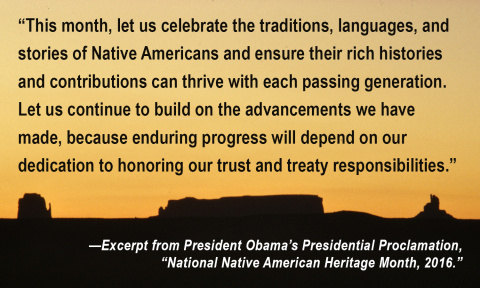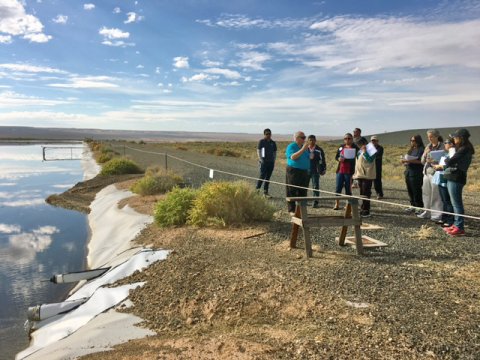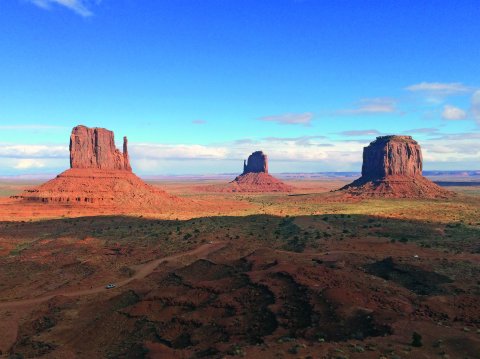Celebrating the consultation and collaboration between DOE's of Legacy Management and Native American and Alaska Native governments and communities.
January 18, 2017National Native American Heritage Month, November 2016, provided an opportunity to recognize the important consultation and collaboration between the U.S. Department of Energy Office of Legacy Management (LM) and Native American and Alaska Native governments and communities. As a part of its tribal work, LM conducts long-term surveillance and maintenance (LTS&M) activities, consultation, collaboration, outreach, and information sharing.
LM performs LTS&M at sites located on, near, or historically used by seven tribal nations, including Aleut, Inupiaq, Jicarilla Apache, Northern Arapaho/Eastern Shoshone Tribes, Hopi Tribe, and the Navajo Nation. LM’s work at these sites includes addressing groundwater contamination, sampling, and environmental characterization. Cooperative agreements and grants between LM and participating Native American and Alaska Native governments and communities provide financial support for tribal technical oversight of LM activities on tribal lands. LM also actively shares information with tribal communities through other means. For instance, LM recently conducted open houses at the Tuba City, Arizona, Chapter House and Monument Valley High School in Utah, and a scoping meeting and site tour of the former Rare Metals Uranium Mill Site in Tuba City. LM is coordinating a future open house event at the Shiprock, New Mexico, site. Participation by Navajo and federal agencies is encouraged and several agencies have participated in the open houses.
LM conducts applied science studies on improving groundwater cleanup for contamination left from uranium milling on tribal lands. Using an environmentally sustainable approach, LM recently completed a long-term study on the use of native plants for remediating nitrate plumes resulting from past milling practices at the Monument Valley, Arizona, uranium processing site. Area residents and Diné College students assisted in the study by irrigating the vegetative plots and collecting data on plant growth. The successful study was representative of the collaborative efforts between LM and the Navajo Nation.
LM engaged with Native American students recently at the Science, Technology, Engineering, and Math (STEM)-oriented Discovery Festival in Farmington, New Mexico. Representatives from LM, Navarro Research and Engineering, Inc. (LM contractor), and the Navajo Abandoned Mine Lands/Uranium Mill Tailings Remedial Action (Navajo AML/UMTRA) program interacted with grade school students and parents. The purpose of this event was to spark student interest in STEM-related fields.
| Participants learn about LM’s Tuba City, Arizona, site during an October 2016 site tour. |
LM and LM contractors also work with environmental sciences classes from the Diné College campuses in Shiprock, New Mexico, and Tsaile, Arizona. The college students assist with soil and water sampling and participate in discussions on site monitoring activities. The Monument Valley site has a test bed that students use to learn soil sampling techniques. In addition, an LM support contractor has been a long-time guest lecturer at Diné College. His lectures have included scientific topics such as soil sampling methods.
LM coordinates with Native American tribes concerning cultural resource protection at its sites. Section 106 of the National Historic Preservation Act requires that LM discuss possible cultural resource effects of its projects with potentially affected Native American tribes. When planning work, LM identifies Native American tribes that might attach religious and cultural significance to potentially affected historic properties and invites them to be consulting parties.
LM also coordinates with the Navajo Nation, the Hopi Tribe, and multiple federal agencies as part of the congressionally mandated Five-Year Plan, Federal Actions to Address Impacts of Uranium Contamination in the Navajo Nation. The plan addresses uranium contamination within the Navajo Nation and the Hopi reservation. Federal agencies involved with the plan include the Bureau of Indian Affairs, U.S. Environmental Protection Agency, Indian Health Service, U.S. Nuclear Regulatory Commission, and the Centers for Disease Control and Prevention. Navajo agencies or departments involved with the plan are Navajo AML/UMTRA, Navajo Nation Environmental Protection Agency, Navajo Department of Health, and Navajo Nation Abandoned Uranium Mines Environmental Response Trust. The Hopi department involved with the plan is from the Office of Mining and Mineral Resources. Federal, Navajo, and Hopi agencies or departments coordinate information sharing and outreach activities to introduce tribal stakeholders to agency roles and responsibilities. The Five-Year Plan participating agencies conducted community outreach at tribal fairs in Tuba City and Window Rock, Arizona, and in Shiprock during September and October 2016.
Nationally, LM participates in the State and Tribal Government Working Group (STGWG). STGWG is composed of policy-level representatives of states and tribes that host DOE facilities or are otherwise affected by activities at DOE facilities. Its composition offers a unique perspective on issues such as long-term stewardship, tribal issues, transportation planning, nuclear waste and materials disposition, and deactivation and decommissioning activities.
LM is dedicated to honoring its responsibilities to Native American and Alaska Native governments and communities. We could not do this work effectively without conducting outreach to tribal communities and gaining valuable input and feedback from local tribal residents.
| Monument Valley, Arizona |




